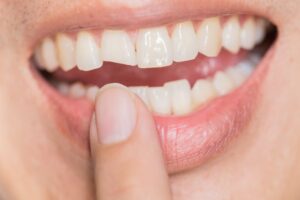
A broken tooth can happen when you least expect it — during a meal, a fall, or even from biting into something hard. Whether it’s a minor chip or a severe fracture, a broken tooth can cause pain, sensitivity, and worry. But don’t panic! Knowing what to do in those crucial first moments can make a big difference in saving your tooth and preventing further damage. Here’s a step-by-step guide on how to handle a broken tooth and what to expect when you visit the dentist.
Stay Calm and Assess the Damage
The first thing to do is stay calm. Take a moment to assess your situation. Look in the mirror or have someone help you see the affected area. Is it a small chip, a crack, or a piece that’s completely broken off? Are you bleeding or in pain?
Minor chips or cracks aren’t usually emergencies, but if you’re experiencing significant pain, bleeding, or visible tooth fragments, you should contact your dentist right away.
Rinse Your Mouth and Save Any Pieces
Gently rinse your mouth with warm water to clean away blood and debris. If part of your tooth has broken off, try to find and save the fragment. Place it in a small container with milk, saline solution, or your own saliva — these help preserve the fragment until you can see your dentist.
Avoid scrubbing or handling the piece too much, as it may still be viable for reattachment in some cases.
Control Bleeding and Reduce Swelling
If your mouth is bleeding, gently press a piece of gauze or a clean cloth against the area for about 10 to 15 minutes. If swelling starts, apply a cold compress to your cheek to help reduce inflammation and relieve pain.
Over-the-counter pain relievers like ibuprofen can also help manage discomfort, but avoid placing aspirin directly on your gums or tooth as it can irritate the tissue.
Protect the Tooth Until You See a Dentist
If your broken tooth has sharp or jagged edges, cover it with dental wax, sugar-free gum, or a small piece of gauze to prevent cuts to your tongue or cheeks. Avoid chewing on the affected side of your mouth and stick to soft foods and lukewarm liquids.
Do not attempt to glue or fix the tooth yourself. Only a dentist can safely repair the damage.
Call Your Dentist Immediately
Even if the break seems minor, you should schedule a dental visit as soon as possible. A small chip could expose the inner layers of your tooth, increasing the risk of decay or infection.
Your dentist will determine the best treatment depending on the severity of the break:
- Small chips may be smoothed or repaired with dental bonding.
- Moderate fractures might require a crown to restore function and appearance.
- Severe breaks that reach the pulp may need a root canal or, in extreme cases, extraction and replacement.
Prevent Future Breaks
To protect your teeth going forward:
- Avoid chewing ice, hard candy, or non-food objects.
- Wear a mouthguard if you play sports or grind your teeth at night.
- Keep up with regular dental visits to catch early signs of weakness or decay.
A broken tooth can be alarming, but quick action can save your smile. Rinse, protect, and contact your dentist right away. With proper care, most broken teeth can be repaired — often looking and feeling just as good as before.
About the Practice
Are you suffering from a broken tooth that’s left you square in the middle of a dental emergency? Don’t fret – we can help! At Woodside Dental Care, we have 30-plus years of serving Woodside dental patients. We’ll get you in and see you quickly with a same-day appointment and have in-house dental financing and CareCredit available to help you with paying for treatment. If you’re in pain, don’t delay one minute – schedule an appointment online or call us now at (718) 898-6010.
